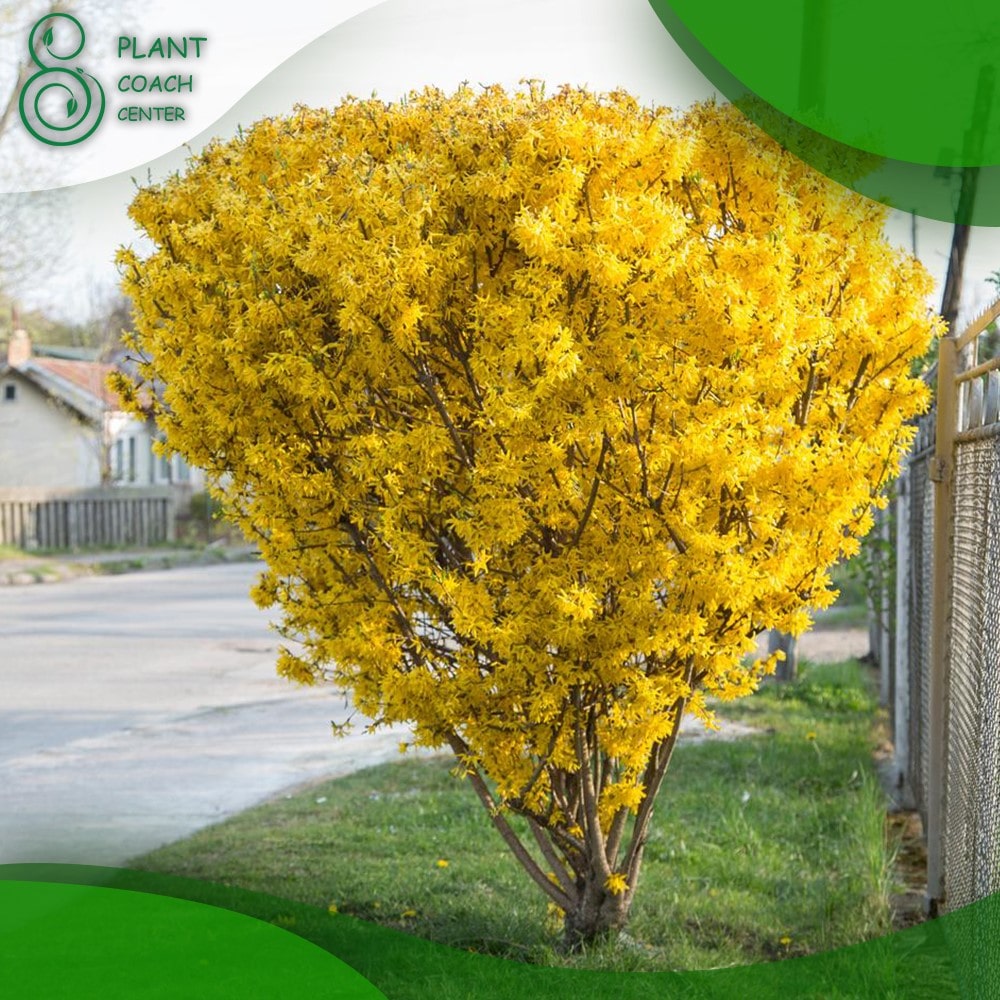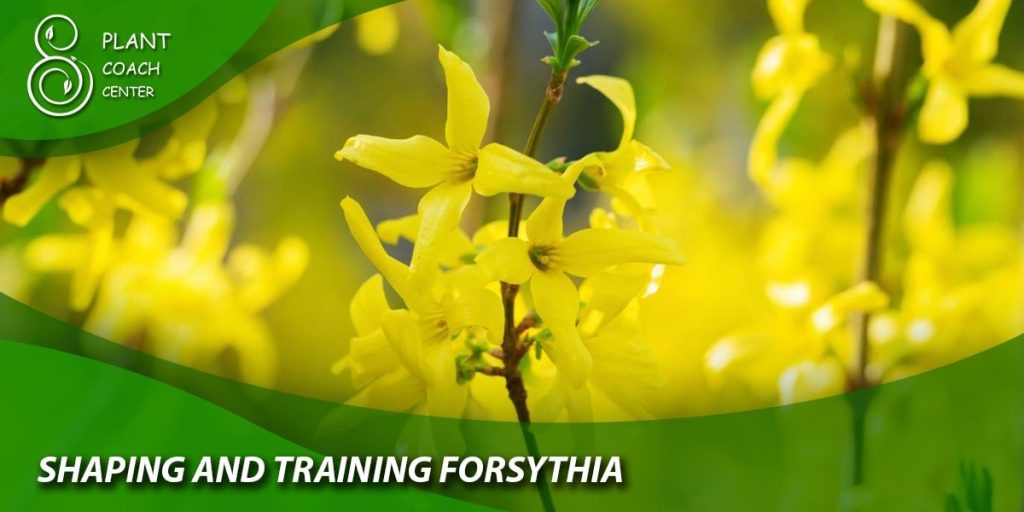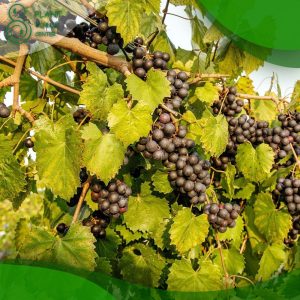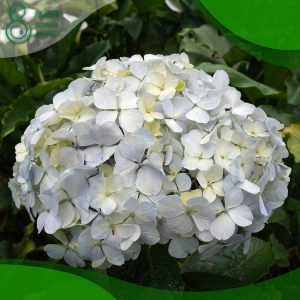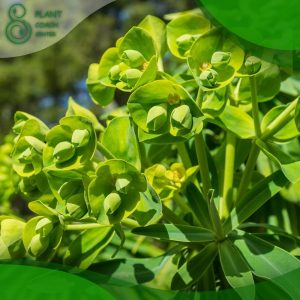When to Cut Back Forsythia
Forsythia, with its vibrant yellow flowers, is a popular deciduous shrub in gardens and landscapes. Proper care and maintenance are essential for ensuring its health and stunning display. In this comprehensive guide, we will explore the world of plant coaching and delve into the best practices for cutting back Forsythia at the right time.
Understanding Plant Coaching and Its Importance
Plant coaching is the art of guiding plants to reach their full potential through proper care, pruning, and shaping. When applied to Forsythia, plant coaching aims to optimize its growth, maintain its health, and enhance its visual appeal.
Overview of Forsythia Care Challenges
Forsythia care comes with its unique set of challenges. Common issues include:
- Pest infestations
- Fungal diseases
- Nutritional deficiencies
- Improper pruning
- Environmental stressors
The Forsythia Plant: Characteristics and Varieties
Before delving into pruning, let’s get acquainted with the Forsythia plant itself.
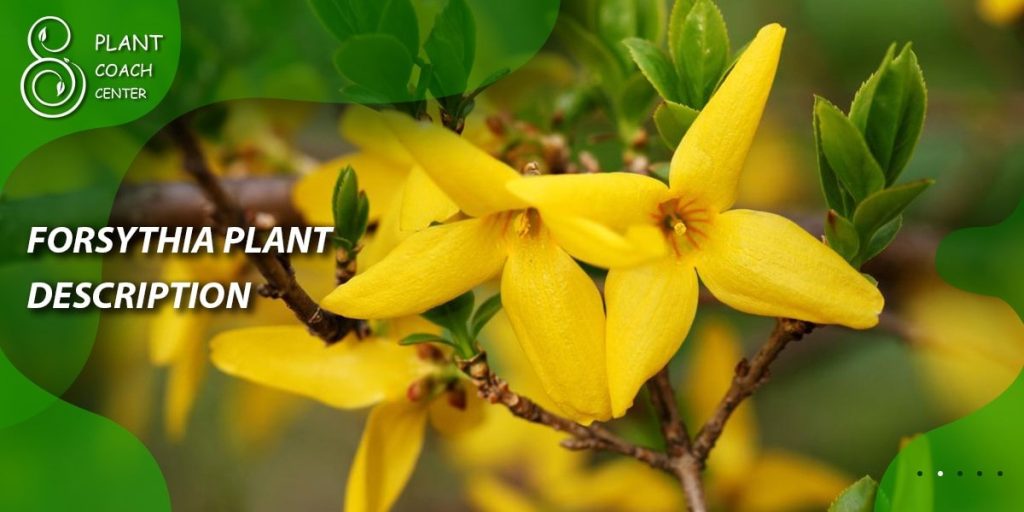
Forsythia Plant Description
Forsythia is a deciduous shrub belonging to the Oleaceae family. It features:
- Arching branches
- Oval-shaped leaves
- Bright yellow flowers
- Height range from 3 to 9 feet (depending on the variety)
Popular Forsythia Varieties
Several Forsythia varieties are cultivated for their unique characteristics:
- Forsythia x intermedia ‘Lynwood Gold’: A fast-growing variety with deep golden flowers.
- Forsythia suspensa: Known for its weeping habit and delicate pale-yellow flowers.
- Forsythia viridissima: Recognized for its early bloom and greenish-yellow flowers.
Ideal Growing Conditions
For optimal growth and blooming, Forsythia thrives under specific conditions:
- Sunlight: Full sun to partial shade.
- Soil: Well-draining, loamy soil with a slightly acidic to neutral pH.
- Watering: Regular watering, especially during dry spells.
- Climate: Hardy in USDA zones 5 to 8.
Plant Health and Growth Cycle
Understanding the growth cycle of Forsythia helps in determining the right time for pruning.
Forsythia Growth Phases
Forsythia undergoes four primary growth phases:
- Dormant Phase: Occurs during late fall and winter when the plant sheds its leaves.
- Bud Swell: Takes place in early spring when buds start to swell and show color.
- Bloom: Forsythia bursts into a profusion of bright yellow flowers in spring.
- Post-Bloom: After flowering, the plant focuses on leaf growth and overall health.
Identifying Healthy vs. Unhealthy Forsythia
Recognizing signs of plant health is vital for effective plant coaching.
- Healthy Forsythia: Lush green foliage, abundant flowers, and vigorous growth.
- Unhealthy Forsythia: Yellowing leaves, wilting branches, lack of blooms, and signs of pest or disease infestations.
Signs of Common Forsythia Problems
Be on the lookout for these issues during plant coaching:
- Aphid Infestations: Curling leaves and sticky residue on foliage.
- Powdery Mildew: White powdery substance on leaves.
- Iron Deficiency: Yellowing leaves with green veins.
The Importance of Pruning Forsythia
Pruning is a crucial aspect of plant coaching, promoting the health and aesthetics of Forsythia.
Why Pruning Matters
Regular pruning serves several purposes:
- Shape Control: Maintain desired growth form and prevent overgrowth.
- Flowering Enhancement: Encourage more blooms by removing older branches.
- Dead Wood Removal: Eliminate diseased or dead wood to prevent further damage.
- Air Circulation: Improve airflow through the plant, reducing disease risk.
Benefits of Pruning Forsythia
Proper pruning leads to numerous advantages for the Forsythia plant:
- Healthier Plant: Eliminates disease-prone branches, enhancing overall plant health.
- Better Aesthetics: Shaping the plant for a more appealing appearance.
- Increased Flowering: Removing old wood stimulates new growth and more flowers.
- Preventing Overgrowth: Restricting size for a more manageable garden.
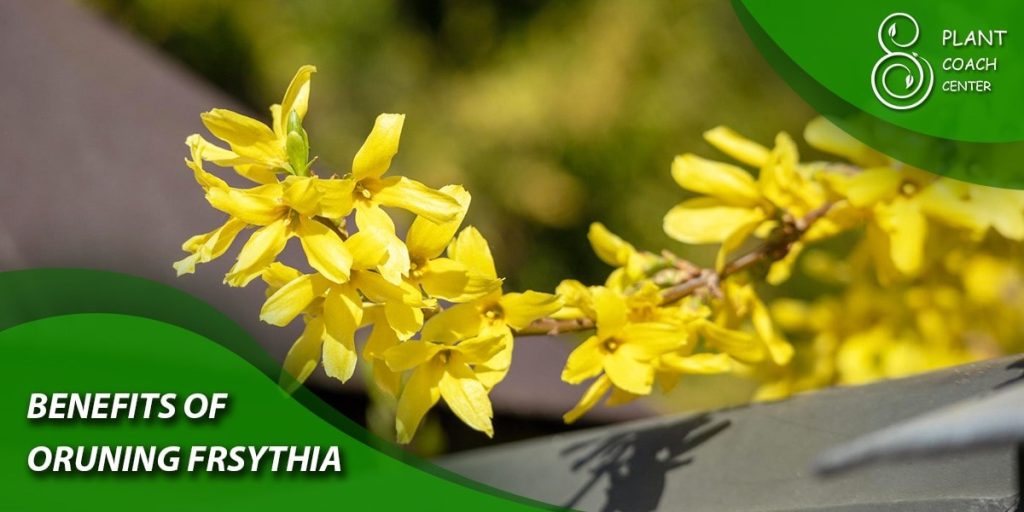
Impact on Plant Health and Aesthetics
When pruning, consider the plant’s health and long-term aesthetics:
- Pruning for Health: Focused on removing dead, damaged, or diseased branches.
- Pruning for Shape: Shaping the plant for a balanced, natural appearance.
Understanding Forsythia’s Pruning Needs
Timing is crucial when it comes to pruning Forsythia effectively.
When to Prune Forsythia
Knowing the best time to prune Forsythia ensures optimal results:
- Pruning After Flowering: Best performed immediately after the bloom cycle ends.
- Late Winter/Early Spring: For rejuvenation pruning, do this before new growth emerges.
Assessing the Right Pruning Time
Consider the Forsythia’s growth phase to determine the appropriate pruning time:
- Post-Bloom Pruning: Allows for shaping without sacrificing the next season’s flowers.
- Rejuvenation Pruning: Severe pruning to rejuvenate an older, overgrown plant.
Considering Regional Variations
Different regions may have specific climate considerations for pruning Forsythia:
- Northern Regions: Late winter or early spring pruning may be better due to harsher winters.
- Southern Regions: Post-bloom pruning to maximize flower display in milder climates.
Step-by-Step Guide to Pruning Forsythia
Proper pruning techniques are vital to ensure the health and vitality of Forsythia.
Tools Required for Pruning
Gather the following tools before you begin:
- Pruning Shears: For smaller branches and precision cuts.
- Loppers: Ideal for thicker branches that pruning shears can’t handle.
- Pruning Saw: Necessary for larger branches.
- Sterilizing Solution: To disinfect the tools and prevent disease spread.
Preparing the Forsythia Plant for Pruning
Before you start pruning, take these steps:
- Inspect the Plant: Identify dead, diseased, and crossing branches for removal.
- Sanitize Tools: Disinfect pruning tools to prevent infections.
- Select the Right Time: Choose between post-bloom or late winter/early spring pruning.
Proper Pruning Techniques for Different Growth Stages
Different pruning methods suit various growth stages of Forsythia:
- Post-Bloom Pruning:
- Remove one-third of the old wood, focusing on thick, older branches.
- Cut at the base of the branch to promote new growth.
- Trim selectively to shape the plant, maintaining a natural appearance.
- Rejuvenation Pruning:
- Cut the entire plant down to about 6 to 12 inches above the ground.
- This drastic pruning stimulates new growth and rejuvenates an overgrown plant.
- Water and fertilize the plant well after rejuvenation pruning.
Common Forsythia Problems and Solutions
Addressing common issues ensures the health and beauty of your Forsythia plant.
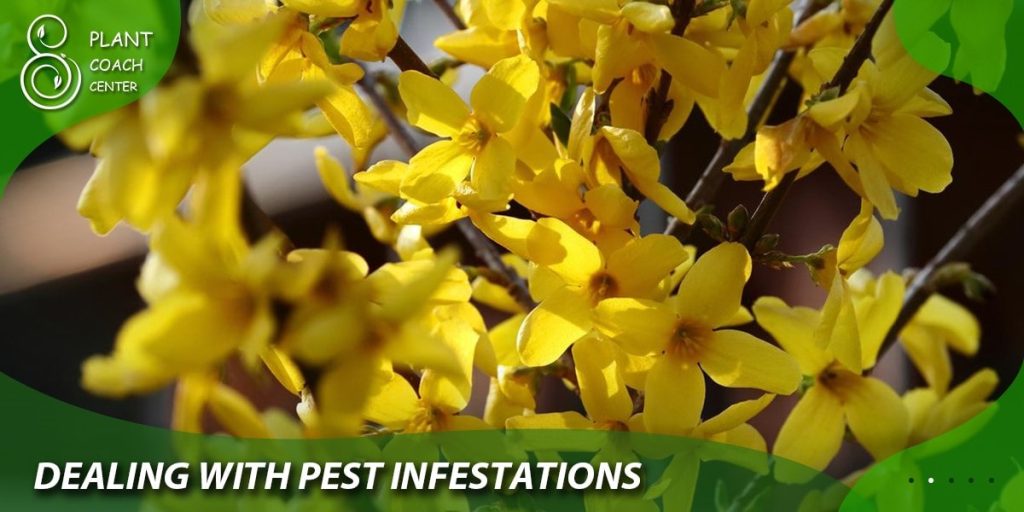
Dealing with Pest Infestations
Aphids, scale insects, and caterpillars may attack Forsythia. Take these steps to manage pests:
- Natural Predators: Encourage beneficial insects like ladybugs to control aphids.
- Horticultural Oil: Use a neem or horticultural oil solution to suffocate pests.
- Insecticidal Soap: Spray on affected areas for non-toxic pest control.
Managing Fungal Diseases
Forsythia is susceptible to fungal diseases such as powdery mildew and leaf spot:
- Prune Affected Parts: Remove infected branches and leaves to prevent spread.
- Fungicide Treatment: Apply a fungicidal spray to control fungal growth.
- Improved Air Circulation: Trim dense areas to improve airflow and reduce humidity.
Addressing Nutritional Deficiencies
Identify and resolve nutrient deficiencies for a healthy Forsythia:
- Soil Testing: Conduct soil tests to determine nutrient deficiencies.
- Fertilization: Apply appropriate fertilizers to address nutrient imbalances.
- Organic Matter: Incorporate compost or organic matter into the soil for better nutrient retention.
Environmental Factors Affecting Forsythia Growth
Various environmental factors play a role in the health and growth of Forsythia.
Sunlight Requirements and Exposure
Forsythia thrives in full sun but tolerates partial shade:
- Full Sun: Provides the most robust flowering and overall growth.
- Partial Shade: Suitable in hotter climates to protect from scorching sun.
Soil Conditions and pH Levels
Well-draining, slightly acidic to neutral soil is ideal for Forsythia:
- Soil Drainage: Amend heavy clay soils for better drainage.
- pH Levels: Aim for a pH range between 6.0 to 7.5.
Watering Techniques and Frequency
Maintain proper watering practices for Forsythia:
- Deep Watering: Water deeply, allowing the soil to dry between watering sessions.
- Avoid Overwatering: Prevent waterlogged soil, which can lead to root rot.
Advanced Plant Coaching: Shaping and Training Forsythia
Taking Forsythia care to the next level involves shaping and training the plant for unique designs.
Topiary Techniques for Forsythia
Topiary involves shaping plants into ornamental forms:
- Cone Shape: Prune the Forsythia into a cone shape for a classic topiary look.
- Spiral Form: Create a spiral pattern by carefully trimming the branches.
- Animal Shapes: With patience and precision, sculpt the Forsythia into animal shapes.
Creating Unique Forms and Designs
Unleash your creativity by experimenting with various designs:
- Arches and Tunnels: Train the branches to form arches and tunnels.
- Living Fence: Arrange multiple Forsythia plants to create a living fence.
- Forsythia Bonsai: Miniaturize the plant into a stunning Forsythia bonsai.
Ensuring Proper Growth after Shaping
Post-shaping care is essential for Forsythia’s recovery:
- Watering: Keep the plant well-hydrated to aid in recovery and new growth.
- Fertilization: Apply a balanced fertilizer to support new shoots.
- Monitoring: Watch for any signs of stress or adverse reactions to shaping.
Forsythia Propagation: Growing New Plants
Expand your Forsythia collection through successful propagation techniques.
Methods of Propagation
Choose from these common propagation methods:
- Softwood Cuttings: Take cuttings from new, flexible growth in early summer.
- Hardwood Cuttings: Harvest mature, woody stems in late autumn or winter.
- Division: Split mature Forsythia plants at the rootball during spring.
Tips for Successful Propagation
Follow these tips to increase propagation success rates:
- Healthy Plant Selection: Choose healthy, disease-free parent plants for cuttings.
- Rooting Medium: Use a well-draining rooting medium, such as a mix of perlite and peat.
- Moisture Control: Maintain consistent moisture levels without waterlogging.
Transplanting Forsythia Offshoots
Successfully transplant new Forsythia offshoots into the garden:
- Timing: Transplant after the new plant develops roots and shows strong growth.
- Site Preparation: Choose a location with appropriate sunlight and soil conditions.
- Watering and Mulching: Keep the transplanted offshoot well-watered and mulched.
Forsythia in Landscaping and Garden Design
Incorporating Forsythia strategically enhances the overall appeal of your garden.

Incorporating Forsythia in Different Garden Themes
Forsythia fits well in various garden themes:
- Cottage Garden: Forsythia’s natural charm complements the cottage aesthetic.
- Formal Garden: Shaping Forsythia into topiary elements adds elegance to formal designs.
- Woodland Garden: Forsythia brightens shady spots with its vibrant flowers.
Combining Forsythia with Other Plants
Pairing Forsythia with compatible plants creates stunning visual combinations:
- Spring Bulbs: Daffodils and tulips alongside Forsythia create a vibrant spring display.
- Evergreen Shrubs: Pair with evergreens to provide year-round interest.
- Complementary Colors: Consider the color wheel to select harmonious plant combinations.
Best Landscaping Practices
Adopt these practices for a well-maintained Forsythia landscape:
- Proper Spacing: Allow sufficient space between Forsythia and other plants for healthy growth.
- Mulching: Apply organic mulch around the base of the plant to conserve moisture and deter weeds.
- Seasonal Maintenance: Regularly prune and shape Forsythia to maintain desired aesthetics.
Seasonal Care for Forsythia
Adopt seasonal care routines to keep your Forsythia in top condition throughout the year.
Spring Care Routine
Spring is a crucial time for Forsythia, as it bursts into bloom:
- Post-Bloom Pruning: After flowering, trim selectively to maintain shape and size.
- Fertilization: Apply a balanced fertilizer to support new growth and flower production.
- Pest Inspection: Check for early signs of pest infestations and take appropriate measures.
Summer Maintenance Tips
Keep your Forsythia thriving during the hot summer months:
- Watering: Regularly water during prolonged dry spells to prevent stress.
- Mulching: Renew the mulch layer to conserve moisture and keep the roots cool.
- Monitor Growth: Watch for excessive growth that may require shaping to maintain desired form.
Preparing Forsythia for Winter
Help your Forsythia withstand the challenges of winter:
- Fall Pruning: Complete any necessary shaping and maintenance pruning before dormancy.
- Mulching: Add a thick layer of mulch to protect the roots from freezing temperatures.
- Winterizing: Consider burlap or windbreaks to shield the plant from harsh winds.
Troubleshooting Forsythia Issues
Be prepared to address common problems that may arise during Forsythia care.
Yellowing Leaves and Leaf Drop
Yellowing leaves and premature leaf drop may indicate various issues:
- Watering: Both under and overwatering can cause leaf discoloration.
- Nutrient Deficiencies: Check soil pH and provide appropriate fertilization.
- Disease: Examine for signs of fungal or bacterial infections and treat accordingly.
Stunted Growth and Poor Flowering
If your Forsythia isn’t blooming as expected:
- Sunlight: Ensure it receives adequate sunlight for optimal flowering.
- Pruning: Evaluate the timing and technique of your pruning practices.
- Nutrition: Address potential nutrient deficiencies through soil testing and fertilization.
Wilting and Drying of Branches
Wilting and drying branches require immediate attention:
- Watering: Ensure the plant receives enough water during dry spells.
- Root Issues: Check for root rot or other root-related problems.
- Pest Infestation: Examine for signs of pests that may be causing damage.
Case Studies: Success Stories in Forsythia Care
Explore real-life examples of successful plant coaching with Forsythia.
Real-Life Examples of Successful Plant Coaching
Share stories of gardeners who achieved outstanding results with Forsythia care:
- Dramatic Transformations: From overgrown and neglected to thriving and well-shaped.
- Creative Designs: Showcasing unique shapes and topiary techniques.
Challenges Faced and Solutions Implemented
Discuss the obstacles encountered during Forsythia care and how they were overcome:
- Pest Infestations: Strategies used to combat various pests.
- Disease Management: Success in controlling fungal and bacterial diseases.
- Rejuvenation Pruning: Demonstrating the benefits and results of severe pruning.
Lessons Learned from Forsythia Enthusiasts
Share valuable insights and tips from experienced Forsythia enthusiasts:
- Pruning Techniques: Advice on timing, methods, and best practices.
- Growth Stimulation: How to encourage vigorous flowering and new growth.
- Garden Design Integration: Tips for incorporating Forsythia effectively in diverse landscapes.
Conclusion
Recapitulate the importance of plant coaching for Forsythia and its impact on plant health and aesthetics. Summarize key takeaways and encourage readers to apply their newfound knowledge to cultivate thriving Forsythia plants in their gardens. Emphasize the rewarding experience of caring for this beautiful and versatile shrub.
Can Forsythia be pruned in the fall?
No, it is best to prune Forsythia after flowering in the spring.
How often should I fertilize my Forsythia?
Fertilize once a year in early spring before new growth appears.
Can I grow Forsythia in containers?
Yes, Forsythia can be grown in containers, but ensure proper drainage and regular watering.


